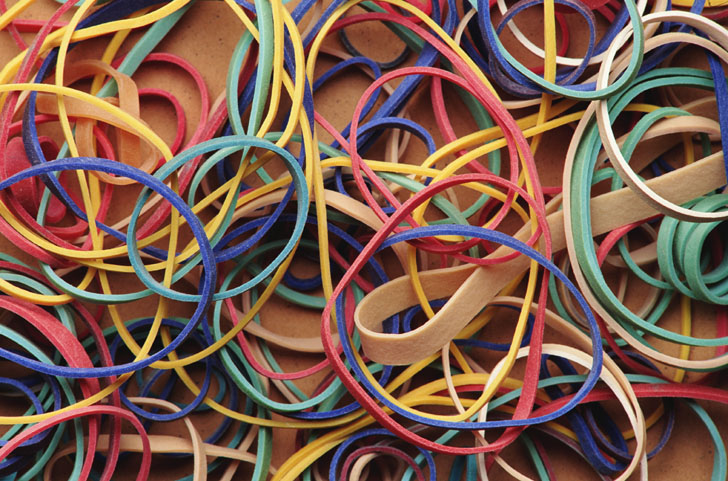Rubber Theory Fits without a Stretch
You can easily measure the force produced by a drastically stretched rubber band. But the standard theory of rubbery materials can’t predict this force. In the 16 February Physical Review Letters, researchers make theory agree with experiment by taking into account a previously neglected aspect of the way rubber molecules move. While the theory won’t provide new insights for tire manufacturers, it solves a scientific problem that has vexed researchers since the 1940s.
Rubbery materials act like simple springs when they’re not deformed too much. Following the relation known as Hooke’s law, a 10 percent increase in stretching force will make a typical rubber band 10 percent longer. But when rubber materials are stretched to twice their original size or more, that simple linear law fails. The cause of that nonlinearity “has been really challenging the physics community for sixty years,” says Paul Goldbart of the University of Illinois at Urbana-Champaign.
Rubber is made of flexible long-chain molecules tied together in places by bonds known as crosslinks that connect atoms in adjacent chains. The arrangement looks like strands of spaghetti stuck to each other at random points. Physicists describe rubber’s tendency to return to its original shape using the laws of entropy, or disorder. A chain molecule that’s fully stretched has just one way to arrange itself, as a straight line, while an unstretched chain can ravel up in many possible ways–corresponding to a state of higher entropy. Stretched rubber snaps back to its original state to maximize its entropy, as thermodynamics demands.
The classical theory of rubber elasticity, developed in the 1940s, adds together the entropies of the free sections between the fixed crosslinks. The theory assumes that, as the rubber is stretched, each crosslink remains stationary–stuck to its local chunk of rubber–even as the chains between crosslinks jiggle around. The jiggling is driven by heat, the usual driver of molecular motion. The 1940s theory predicts a linear relationship between the force and the amount of stretching.
Goldbart and his colleagues modified this theory by including heat-driven movements of the positions of the crosslinks. In their model, rubber’s entropy comes not only from the vibration of molecules between the crosslinks, but also from movement of the crosslinks themselves. “Our approach is to take a fresh look at the impact of thermal fluctuations, particularly those occurring at the chain size or longer,” says coauthor Leo Radzihovsky of the University of Colorado in Boulder. In formulating the theory, the team had to overcome a mathematical challenge: Rubber is incompressible, keeping the same volume no matter how much it bends and twists, but including this property in the theory required some mathematical tricks.
The new theory gives a nonlinear relationship between force and stretching that closely matches rubber’s known properties. “This elegant paper makes the simple point, remarkably missed until now, that fluctuations of the positions of the crosslinking points also contribute” to the forces associated with deforming rubber, says Tom Lubensky of the University of Pennsylvania. “These corrections fit experimental data much better than the classical theory.”
The team says their theory should apply to a wide range of soft elastic materials, and they are devising experimental tests that will show whether the new source of entropy is truly the crucial ingredient. For example, the chemical treatment known as “swelling” takes away rubber’s incompressibility, which should remove much of the additional entropy, according to the new theory. That should bring the material’s behavior into closer agreement with the old theory.
–Ben P. Stein
Ben P. Stein is a senior science writer at the American Institute of Physics.





